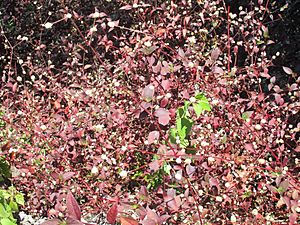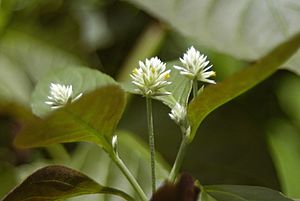Large purple alternanthera facts for kids
Quick facts for kids Large purple alternanthera |
|
|---|---|
 |
|
| Scientific classification | |
| Genus: |
Alternanthera
|
| Species: |
brasiliana
|
| Synonyms | |
|
|
Alternanthera brasiliana, also known by fun names like large purple alternanthera, metal weed, bloodleaf, parrot leaf, ruby leaf, Brazilian joyweed, purple alternanthera, or purple joyweed, is a type of flowering plant. It belongs to the amaranth family, which includes many colorful plants. This plant originally comes from the forests of South America and Central America. People often grow it as an ornamental plant because it's so pretty. It looks a lot like another plant called Alternanthera dentata.
Contents
What Does It Look Like?
This plant is a herbaceous plant, meaning it has soft stems instead of woody ones like trees. It can grow upright or spread out like a groundcover. In gardens, it's usually less than 1 meter (about 3 feet) tall, but in the wild, it can reach up to 3 meters (almost 10 feet)!
The stems of the plant can be red, green, or purple. When they are young, they have fine hairs (this is called hirsute). But as the stems get older, they become smooth (this is called glabrescent).
Its leaves grow in pairs on the stem. They are usually purple-speckled or a bright reddish-purple color. Each leaf can be between 1 and 10 centimeters (0.4 to 4 inches) long and 0.7 to 5 centimeters (0.3 to 2 inches) wide. If the winter is a bit cool, the plant might lose some of its leaves. This makes it partly "deciduous" in those areas.
Flowers and Fruit
The flowers of Alternanthera brasiliana are small and look like vanilla-colored pom-poms. They grow in tight groups, or "compact clusters," at the top of the leaf branches. These clusters are usually round or slightly long, measuring 7 to 20 millimeters (about 0.3 to 0.8 inches). They grow on stalks that are typically 3 to 10 centimeters (1.2 to 4 inches) long.
This plant can flower at any time of the year. However, in places with cooler weather, like temperate or cooler subtropical areas, it flowers more often in winter. The plant also produces very tiny brown fruits, about 1.5 to 2 millimeters (0.06 to 0.08 inches) long. Each fruit holds one small seed, which is usually hidden inside the old flower parts.
How People Use and Grow It
Alternanthera brasiliana is a popular ornamental plant because of its colorful leaves. There are many different types, called "cultivars," that people grow. Some well-known ones are 'Purple Prince' and 'Little Ruby'. (Be careful, 'Little Ruby' is also a name for a similar plant, Alternanthera dentata!)
In some parts of the world, people gather this plant from the wild. They use it for food and in traditional medicine. For example, it has been used to help with certain health issues like viruses or diarrhea.
If you want to grow this plant, it likes to be in full sun. It also needs soil that is moist but drains water well. The plant can spread by itself because its seeds will grow into new plants (this is called "self-seeding"). You can also easily grow new plants from pieces of the stem, which is known as taking cuttings.
Where It Grows Naturally
This plant is originally from many countries in Central and South America. These include Brazil, Peru, Ecuador, Colombia, Venezuela, the Guyanas, Nicaragua, Belize, Guatemala, Mexico, and the Caribbean islands.
It has also started growing on its own in other parts of the world. You can find it in the wild and on farms in west Africa, along the coasts of northern and eastern Australia, in Florida in the USA, in South Africa, and on some Pacific Islands. It also grows in shady valleys and near creeks in Java.
In some places, like Queensland, New South Wales, the Northern Territory, and Western Australia in Australia, many types of joyweed, including this one, are considered "environmental weeds." This means they can grow very quickly and take over areas, sometimes pushing out native plants.
Gallery
See also
 In Spanish: Alternanthera brasiliana para niños
In Spanish: Alternanthera brasiliana para niños










